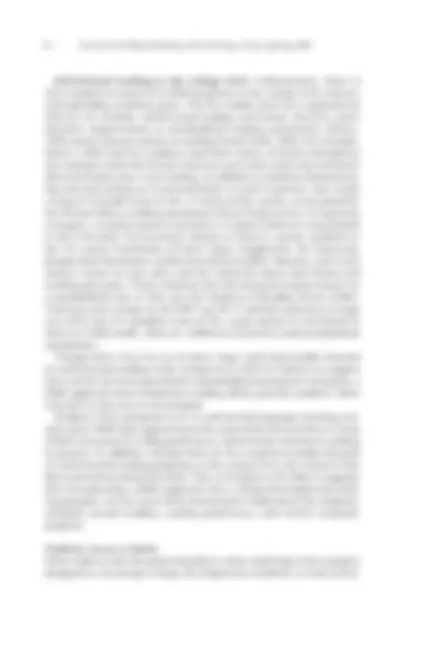






Study with the several resources on Docsity

Earn points by helping other students or get them with a premium plan


Prepare for your exams
Study with the several resources on Docsity

Earn points to download
Earn points by helping other students or get them with a premium plan
Community
Ask the community for help and clear up your study doubts
Discover the best universities in your country according to Docsity users
Free resources
Download our free guides on studying techniques, anxiety management strategies, and thesis advice from Docsity tutors
The importance of encouraging self-selected reading for enjoyment by college developmental students as a key to generating both academic success and a love of reading. The article proposes that a focus on instilling the belief that reading has intrinsic value is essential for long-term development of students as readers. Extensive research is presented on the benefits of self-selected reading, including increased reading speed and comprehension, improved writing skills, and increased motivation to read.
Typology: Study notes
1 / 8

This page cannot be seen from the preview
Don't miss anything!





Self-Selected
Reading for
Enjoyment
as a College
Developmental
Reading
Approach
The field of college developmental reading does not have a unified, agreed- upon approach to creating effective and efficient readers at the college level, as Reynolds and Werner (2003) have pointed out. For example, Keefe and Meyer (1991) assert the appropriateness of a holistic, whole-language approach for adult readers, while Bohr (2003) maintained that a constructivist approach can confuse college readers. Despite college developmental educators calling for learner-centered approaches like reader response (e.g., Chamblee, 2003), a direct instruction, skills-based approach has a solid foothold in college de- velopmental reading programs. The influence of the latter is evident in even the most cursory glance at many college reading textbooks, which show a focus on word-level skill building, with exercises that emphasize analyzing the roots of words and defining and memorizing vocabulary items. When text excerpts longer than a paragraph are provided in these textbooks, they are often followed by discrete point questions about factual, objective aspects of the text. If we accept that to an extent, textbooks reflect the type of teaching going on in the classroom (Wood, 2003), then college developmental reading practice is often typified by a focus on word-attack strategies and discrete- skill building. In addition, college developmental reading is often seen as consisting of content-area textbook reading and study assistance—a way to “get students through” their other college courses. In some contexts, a focus on skill building can be beneficial for many aspects of students’ academic lives given an appropriate metacognitive, strategy-construction approach. However, I propose that if we identify an important goal of developmental reading programs for college readers as providing a foundation for life-long
Self-Selected Reading for Enjoyment 51
52 Journal of College Reading and Learning, 36 (2), Spring 2006
reading, a study-skills approach to college developmental reading falls short. Instead, we must focus on encouraging and instilling in developmental reading students the belief that reading has intrinsic value. It is through this approach that solid academic progress can be obtained as well.
propose that encouraging self-selected reading for enjoyment by college developmental students is the key to generating both academic success and a love of reading. Free voluntary reading is a term coined by Krashen (2004) to describe “reading because you want to: no book reports, no questions at the end of the chapter” (p. 1). The term parallels others, such as self-selected reading (Cunningham, Hall, & Gambrell, 2002), ex- tensive reading (Susser & Robb, 1990), sustained silent reading (McCraken, 1971), and more general descriptors like pleasure reading or free read- ing. Self-selected reading for enjoyment , shortened to SSRE for reasons of economy, will be the default term used here. A working definition of SSRE is reading for the sake of reading—fiction works independently chosen by college developmental readers to read for enjoyment or other intrinsically motivated reasons. Concerns of reading educators about approaches that focus on and encourage holistic reading for the sake of reading understandably center around whether that approach can provide students with the vocabulary development and reading skills they need to succeed in college. The next section addresses how such an approach can be considered a viable part of a college developmental reading program.
Empirical Research on Self-Selected Reading A curious, but fairly widespread, approach to developmental reading at many levels of education is that readers who are underperforming are given less opportunity to read authentic texts and instead given more drills and out-of-context instruction that involve little if any connected reading. In other words, poor readers get less reading and more work- sheets, which only serves to increase the gap between good readers and poor readers (Allington, 1980; Krashen 2004). This trend toward giving troubled readers less authentic reading than their more proficient class- mates is replicated in college developmental reading classes if the class is built around word analysis instead of being built around reading real texts. In fact, this bias toward explicit skill-and-drill instruction may be bolstered simply because of the lack of a tradition of SSRE approaches
54 Journal of College Reading and Learning, 36 (2), Spring 2006
Self-selected reading at the college level. Unfortunately, there is little empirical research on SSRE programs at the college level and any corresponding academic gains. The few studies that have explored the efficacy of a holistic, self-selected reading curriculum, however, show dynamic improvement in standardized reading assessment (Henry,
Problem: Access to Books With evidence like that presented above, most would agree that a project designed to encourage college developmental students to read self-se-
Self-Selected Reading for Enjoyment 55
lected fiction for enjoyment on a regular basis is worthy, and that success in raising students’ academic reading skills and general reading ability and confidence is likely. While step-by-step suggestions for a SSRE cur- riculum do not yet exist, Henry’s (1995) book If Not Now: Developmental Readers in the College Classroom provides an engaging primer to such an approach. A key element in such a project, however, is access to books, as there is a positive correlation between access to books and reading ability (Krashen, 1995, 2004). Access in this sense means ability and tendency for students to easily obtain books—a public library a bus ride away seems accessible on paper, but in practical terms is not used as often as a source of books immediately accessible in, for example, the same building in which students attend classes. This is one reason that Elley’s (1996) “book flood” programs, where the researcher provided numerous high interest books directly to students’ classrooms, were so successful in generating patterns of extensive reading. In addition, in a multiple regression analysis that utilized data from 41 states in the U.S., Krashen (1995) found that significant predictors of National Assessment of Educational Progress (NAEP) reading comprehension test scores were the number of books per student in school libraries. These data point to a key element of extensive reading programs being the immediate accessibility of a variety of books for students to choose from. The focus of this article concerns the importance of incorporating a SSRE approach in college developmental reading courses, and one impor- tant aspect of such an approach is encouraging reading above and beyond the class time frame. Because there is evidence that the longer a free voluntary reading program is run, the more effective it is (Krashen, 2004, p. 3), the more a college reading program can encourage and convince readers that reading for the sake of reading is intrinsically interesting and valuable, the more success those students will experience. To that end, a grant has recently been received at the University of Cincinnati to begin an on-site fiction lending library at the Center for Access and Transition, an open-access unit of the university that focuses on devel- opmental education and underprepared readers. The make-up of the lending library will consist of high-interest fiction (novels, novellas, short stories, poetry, etc. from a wide variety of genre) which will alleviate the problem some of the university’s students experience of limited access to books. One challenge will be to incorporate the lending library into curricula so that reading self-selected books for enjoyment eventually becomes part of the culture of the course of study at the Center.
Traditional college developmental reading approaches of word-attack
Self-Selected Reading for Enjoyment 57
Cunningham, P. M., Hall, D. P., & Gambrell, L. B. (2002). Self-selected reading the four-blocks way. Greensboro, NC: Carson-Dellosa Publishers. Day, R., Omura, C., & Hiramatsu, M. (1991). Incidental EFL vocabulary learning and reading. Reading in a Foreign Language, 7 (2), 541-551. Elley, W. (1996). Using book floods to raise literacy levels in developing countries. In V. Greaney (Ed.), Promoting reading in developing countries: Views on making reading materials accessible to increase literacy levels (pp. 148-163). Newark, DE: International Reading Association. Hafiz, F. M., & Tudor, I. (1989). Extensive reading and the development of language skills. English Language Teaching Journal, 43 , 4-13. Henry, J. (1995). If not now: Developmental readers in the college classroom. Portsmouth, NH: Heinemann. H i to s u g i , C. I. & D a y , R. R. ( 2 0 0 4 ). E x t e n s i ve re a d i n g i n J a p a n e s e. Reading in a Foreign Language, 16 (1). Retrieved September 14, 2005, from http://nflrc.hawaii.edu/rfl/April2004/hitosugi/hitosugi.html. Keefe, D. & Meyer, V. (1991). Teaching adult readers the whole language way. Journal of reading, 35 (3), 180-183. Kembo, J. (1993). Reading: Encouraging and maintaining individual extensive reading. English Teaching Forum, 31 (2), 36-38. Krashen, S. D. (1995). School libraries, public libraries, and the NAEP reading scores. School Library Media Quarterly, 22 (4), 235-237. Krashen, S. D. (2004). The power of reading: Insights from the research (2nd^ Ed.). Westport, CT: Libraries, Unlimited, Portsmouth, NH: Heinemann. McCracken, R.A. (1971). Initiating sustained silent reading. Journal of Reading , 14 (8), 521-524, 582-583. Reynolds, J. & Werner, S. C. (2003). An alternative paradigm for college reading and study skills courses. In N. A. Stahl & H. Boylan (Eds.), Teaching developmental read- ing: Historical, theoretical, and practical background readings (pp. 86-95). Boston, MA: Bedford/St. Martin’s. Stanovich, K. E. (1986). Matthew effects in reading: Some consequences of individual differences in the acquisition of literacy. Reading Research Quarterly, 21 , 360-406. Stanovich, K. E. & West, R. (1989). Exposure to print and orthographic processing. Reading Research Quarterly, 24 , 402-433. Susser, B. & Robb, T. N. (1990). EFL extensive reading instruction: Research and procedure. JALT Journal, 12 (2). Retrieved September 10, 2005, from http://www.kyoto-su.ac.jp/~trobb/sussrobb.html Valeri-Gold, M. (1995). Uninterrupted sustained silent reading is an effective authentic method for college developmental learners. Journal of Reading , 38 (5), 385-386. Wood, N. V. (2003). College reading instruction as reflected by current reading textbooks. In N. A. Stahl & H. Boylan (Eds.), Teaching developmental reading: Historical, theoretical, and practical background readings (pp. 29-43). Boston, MA: Bedford/St. Martin’s.
58 Journal of College Reading and Learning, 36 (2), Spring 2006
Eric J. Paulson is Associate Professor of Literacy Education at the University of Cincinnati in the College of Education, Criminal Justice, and Human Services, where he teaches in the Graduate Program in Literacy. His research interests include developmental reading processes at the college level. His email address is eric. paulson@uc.edu_._